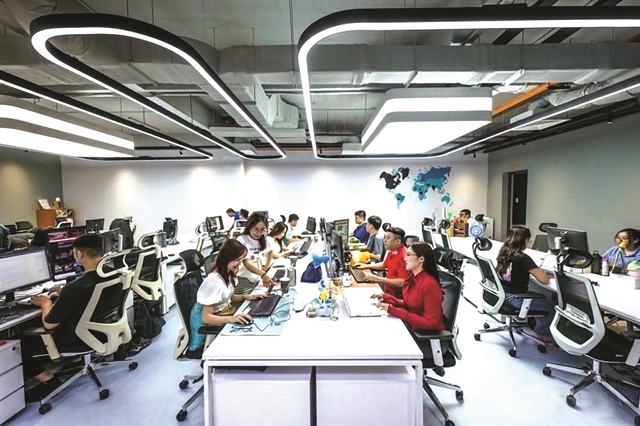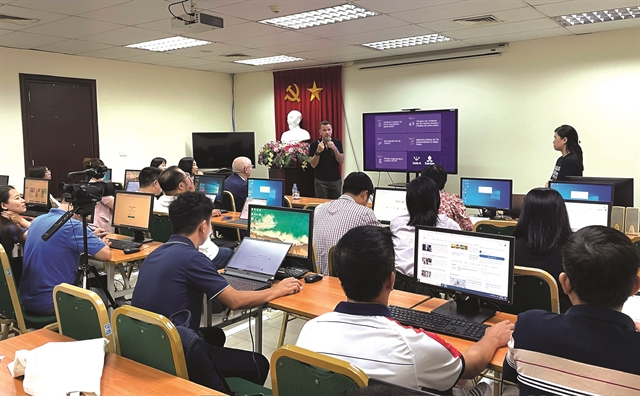 Society
Society

 |
| Việt Nam Women's Golden Ball 2022 winner Huỳnh Như answers the press. With the rise of the internet, smartphones and other smart electronic devices, the growing demand for technology among people has paved the way for a new trend in journalism within the Vietnamese media landscape. |
By Ly Ly Cao
As the global media industry navigates a storm of disruption, from declining print revenues to the rise of generative AI, the path towards sustainable journalism has never been more urgent or more complex.
In Việt Nam and around the world, media leaders are reimagining the future of news, embracing digital tools and revenue innovation to stay relevant, resilient and responsible.
According to the Global Media Landscape Report 2025–2026, the greatest challenge facing journalists today is adapting to rapidly changing audience behaviour.
Over 42 per cent of journalists globally cite this shift as their top concern, surpassing even issues like AI disruption, financial instability and staffing shortages.
"Journalists now have to understand not only what the audience cares about but also how and where they consume content," said Lê Mai Anh, regional country manager at Global PR Hub, at a recent conference on shaping the future of journalism.
Traditional content cycles no longer suffice. With audiences increasingly fragmented across platforms like TikTok, Instagram, podcasts and newsletters, newsrooms are forced to act fast, adapt continuously and compete for attention against influencers and algorithms.
 |
| MULTIFUNCTIONAL: Tuổi Trẻ newspaper's newsroom features a modern and innovative approach. |
Nguyễn Văn Bá, editor-in-chief of Vietnamnet, offered a clear response. "Newsrooms must shift from volume to value, from chasing views to generating social impact," he said.
While speed would remain essential in the digital era, Bá argued that understanding and serving the reader must come first.
His newsroom is now leveraging user behaviour analytics to inform editorial direction. Comments are filtered by AI systems, while content is suggested dynamically based on reader interests.
"Technology is helping us be faster and smarter but also more human," Bá said.
This hybrid model - combining tech efficiency with editorial depth - mirrors the approach of international outlets like The New York Times, which now draws significant revenue from newsletters, interactive graphics and podcasts, or The Guardian, which thrives on voluntary contributions from a loyal reader base.
AI: disruption or leverage?
Generative AI remains a double-edged sword in journalism. As the global report reveals, 72 per cent of journalists worry that AI risks spreading misinformation and reducing creativity.
Yet more than half have already used it at least once, and the same ratio plan to adopt it further.
 |
| NEW SKILLS: Reporters attend an AI training class hosted by the Việt Nam News Agency. VNA/VNS Photos |
At Vietnamnet, AI is deeply integrated into the newsroom’s daily operations. It supports content moderation, search optimisation, headline suggestions and even personalises news feeds for different audience segments.
"AI is not just software. It’s a mindset shift," said Bá. "We are building an editorial culture that treats technology as a partner, not a threat."
This echoes the broader trend across the industry, where AI adoption is high despite concerns.
As content demands grow and trust remains fragile, AI can help journalists manage increasing workloads, automate routine tasks and refocus on storytelling that matters.
Still, even the best content cannot sustain journalism without robust financial support. The crisis of trust in news is matched by a crisis in revenue. Traditional print income continues to decline, while digital ads alone are rarely enough to pay the bills.
"The old model, which is relying on government subsidies or banner ads, can’t support us any more," Bá said. "We must diversify or risk collapse."
There have been some international models. The New York Times boasts over 10 million paying subscribers thanks to its tiered product offerings. Meanwhile, The Guardian sustains its journalism through a contribution economy, welcoming donations from over a million readers annually.
There’s no one-size-fits-all. However, every newsroom must find its balance: between editorial independence and financial viability, between mass appeal and niche loyalty.
Sustainable journalism
For Bá, the future of journalism rests on content, business and technology – but integrated, not isolated.
"These pillars must work in convergence. Editorial staff must understand the product. Business teams must know the audience. Engineers must speak the language of journalism," he said.
This requires not just new systems but new cultures. Cross-functional teams, agile workflows and unified goals are essential. Editorial independence and commercial strategy are no longer opposing forces. They are partners in survival.
It also requires bold leadership.
Lê Quốc Minh, chairman of the Vietnam Journalists’ Association, shared similar insight.
"We must embrace change, even when it’s risky," Minh told Việt Nam News. "Sustainability means being ready to experiment, fail fast and keep evolving."
In a media landscape where trends shift weekly and technologies update every six months, standing still is not an option. The most forward-thinking newsrooms are those that treat innovation not as a one-time project but as a continuous process.
This includes exploring new formats such as short-form video, interactive content and AI-generated data visualisations. It also means tapping into niche communities, experimenting with micropayments and rethinking what a media product can be, perhaps even extending into events, e-commerce or education.
Put simply, sustainable journalism cannot exist without a sustainable business model, and business sustainability is impossible without continuous innovation. BIZHUB/VNS

.jpg)


